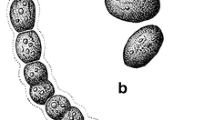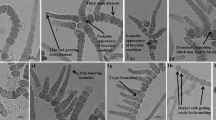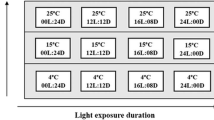Abstract
A false branching cyanobacterium (strain 1F-PS) isolated from a fresh water body of Bilaspur (Chhattisgarh, India) is described here as a new species of the polyphyletic genus Scytonema. Morphological, ecological, molecular and phylogenetic evidence validated the strain as a new species. Observations of the filaments in different phases of growth, different levels of microscopic studies, the presence of a textured thin sheath throughout the length of the trichome, differences in the shape and dimensions of the vegetative cells and heterocytes and ecological attributes show that the strain differed from the rest of the closely related species. Sequencing of the 16S rRNA gene resulted in 99% similarity with Scytonema bilaspurensis and 97.07% sequence similarity with Scytonema hofmannii PCC 7110, while rbcl and psbA sequences showed 99 and 97% similarities with S. bilaspurensis, respectively. Phylogenetic assessments indicated a large phylogenetic distance and separate clustering of the strain 1F-PS for all the molecular markers.





Similar content being viewed by others
References
Aguiar R, Fiore MF, Franco MW, Ventrella MC, Lorenzi AS, Vanetti CA, Alfenas AC (2008) A novel epiphytic cyanobacterial species from the genus Brasilonema causing damage to Eucalyptus leaves. J Phycol 44:1322–1334
Anagnostidis K, Komárek J (1985) Modern approach to the classification system of the cyanophytes 1. Introduction. Algol Stud 38:291–302
Anagnostidis K, Komárek J (1988) Modern approach to the classification system of the cyanophytes 3. Oscillatoriales. Algol Stud 50:327–472
Anagnostidis K, Komárek J (1990) Modern approach to the classification system of the cyanophytes 5. Stigonematales. Algol Stud 86:1–74
Becerra-Absalón I, Rodarte B, Osorio K, Alba-Lois L, Segal-Kischinevzky C, Montejano G (2013) A new species of Brasilonema (Scytonemataceae, Cyanoprokaryota) from Tolantongo, Hidalgo, Central Mexico. Fottea 13:25–38
Berrendero E, Perona E, Mateo P (2008) Genetic and morphological characterization of Rivularia and Calothrix (Nostocales, Cyanobacteria) from running water. Int J Syst Evol Microbiol 58:447–460
Bohunická M, Mareš J, Komárek J (2012) Comparison of the molecular and morphological diversity within the family Scytonemataceae (Nostocales, Cyanobacteria). In: Anonymous, Abstract book of 14 international symposium on phototrophic prokaryotes (ISPP 2012), Porto, Portugal
Bornet É, Flahault C (1887) Revision des Nostocacées hétérocystées contenues dans les principaux herbiers de France (Troisième fragment). Ann Sci Nat Bot 5:51–129
Bornet É, Flahault C (1888) Revision des Nostocacées hétérocystées contenues dans les principaux herbiers de France (quatrième et dernier fragment). Ann Sci Nat Bot 7:177–262
Bourrelly P (1970) Les algues d’eau douce III. N. Boubée & Cie, Paris
Boyer SL, Johansen JR, Flechtner VR, Howard GL (2002) Phylogeny and genetic variance in terrestrial Microcoleus (Cyanophyceae) species based on sequence analysis of the 16S rRNA gene and associated 16S–23S ITS region. J Phycol 38:1222–1235
Büdel B, Kauff F (2012) Blue-green algae. In: Frey W (ed) Syllabus of plant families, Engler’s syllabus der Pflanzenfamilien, part VI. Borntraeger, Stuttgart, pp 5–39
Correns C (1889) Über Dickenwachstum durch Intussusception bei einiger Algenmembranen. Flora 72:1–298
Desikachary TV (1959) Cyanophyta. ICAR Monographs on Algae, New Delhi
Felsenstein J (1981) Evolutionary trees from DNA sequences: a maximum likelihood approach. J Molec Evol 17:368–376
Felsenstein J (1985) Confidence limits on phylogenies: an approach using the bootstrap. Evolution 39:783–791
Fiore MF, Sant’Anna CL, Azevedo MTP, Komárek J, Kaštovský J, Sulek J, Lorenzi AS (2007) The cyanobacterial genus Brasilonema—molecular and phenotype evaluation. J Phycol 43:789–798
Fitch WM (1971) Toward defining the course of evolution: minimum change for a specified tree topology. Syst Zool 20:406–416
Geitler L (1932) Cyanophyceae. In: Kolkwitz R (ed) Rabenhorst’s Kryptogamenflora von Deutschland. Österreich und der Schweiz 14. Algen. Akademische Verlagsgesellschaaft m. b. H., Leipzig, pp 1–1196
Kim OS, Cho YJ, Lee K, Yoon SH, Kim M, Na H, Park SC, Jeon YS, Lee JH, Yi H, Won S, Chun J (2012) Introducing EzTaxon-e: a prokaryotic 16S rRNA gene sequence database with phylotypes that represent uncultured species. Int J Syst Evol Microbiol 62:716–721
Kimura M (1980) A simple method for estimating evolutionary rate of base substitutions through comparative studies of nucleotide sequences. J Molec Evol 16:111–120
Komárek J (2013) Cyanoprokaryota. 3. Heterocytous genera. In: Büdel B, Gärtner G, Krienitz L, Schagerl M (eds) Süswasserflora von Mitteleuropa/freshwater flora of Central Europe 19/3. Springer Spektrum, Berlin, pp 1–1130
Komárek J, Anagnostidis K (1986) Modern approach to the classification system of the cyanophytes 2. Chroococcales. Algol Stud 43:157–226
Komárek J, Anagnostidis K (1989) Modern approach to the classification system of the cyanophytes 4. Nostocales. Algol Stud 56:247–345
Komárek J, Anagnostidis K (1998) Cyanoprokaryota 1. Chroococcales. In: Ettl H, Gärtner G, Heynig H, Mollenhauer D (eds) Süsswasserflora von Mitteleuropa 19/1. Gustav Fischer, Jena, pp 1–548
Komárek J, Kaštovský J, Mareš J, Johansen JR (2014) Taxonomic classification of cyanoprokaryotes (cyanobacterial genera) using a polyphasic approach. Preslia 86:295–335
Rippka R, Deruelles J, Waterbury JB, Herdman MR, Stanier RY (1979) Generic assignments, strain histories and properties of pure cultures of Cyanobacteria. J Gen Microbiol 111:1–61
Saitou N, Nei M (1987) The neighbor-joining method: a new method for reconstructing phylogenetic trees. Molec Biol Evol 4:406–425
Sant’anna CL, Azevedo MTP, Fiore MF, Lorenzi AS, Kaštovský J, Komárek J (2011) Subgeneric diversity of Brasilonema (Cyanobacteria, Scytonemataceae). Revista Brasil Bot 34:51–62
Singh P, Fatma A, Mishra AK (2015a) Molecular phylogeny and evogenomics of heterocystous cyanobacteria using rbcl gene sequence data. Ann Microbiol 65:799–807
Singh P, Singh SS, Aboal M, Mishra AK (2015b) Decoding cyanobacterial phylogeny and molecular evolution using an evonumeric approach. Protoplasma 252:519–535
Singh P, Minj RA, Kunui K, Shaikh ZM, Suradkar A, Shouche YS, Mishra AK, Singh SS (2016) A new species of Scytonema isolated from Bilaspur, Chhattisgarh, India. J Syst Evol 5:519–527. doi:10.1111/jse.12202
Starmach K (ed) (1966) Flora slodkowodna Polski 2. Cyanophyta-sinice, Glaukophyta-glaukofity. Panstwowe Wydawnictwo Naukowe, Warszawa
Strackerbrandt E, Ebers J (2006) Taxonomic parameters revisited: tarnished gold standards. Microbiol Today 33:152–155
Tamura K, Nei M (1993) Estimation of the number of nucleotide substitutions in the control region of mitochondrial DNA in humans and chimpanzees. Molec Biol Evol 10:512–526
Tamura K, Peterson D, Peterson N, Stecher G, Nei M, Kumar S (2011) MEGA5: molecular evolutionary genetics analysis using maximum likelihood, evolutionary distance, and maximum parsimony methods. Molec Biol Evol 28:2731–2739
Thompson JD, Gibson TJ, Plewniak F, Jeanmougin F, Higgins DG (1997) The CLUSTAL_X windows interface: flexible strategies for multiple sequence alignment aided by quality analysis tools. Nucleic Acids Res 25:4876–4882
Vaccarino MA, Johansen JR (2011) Scytonematopsis contorta sp. nov. (Nostocales), a new species from the Hawaiian Islands. Fottea 11:149–161
Vaccarino MA, Johansen JR (2012) Brasilonema angustatum sp. nov. (Nostocales), a new filamentous cyanobacterial species from the Hawaiian Islands. J Phycol 8:1178–1186
Xia X (2013) DAMBE5: a comprehensive software package for data analysis in molecular biology and evolution. Molec Biol Evol 30:1720–1728
Zapomělová E, Hrouzek P, Řezanka T, Jezberová J, Řeháková K, Hisem DJR, Komárková J (2011) Polyphasic characterization of Dolichospermum spp. and Sphaerospermopsis spp. (Nostocales, Cyanobacteria): morphology, 16S rRNA gene sequences and fatty acid and secondary metabolite profiles. J Phycol 47:1152–1163
Acknowledgements
We are thankful to the Council of Scientific and Industrial Research, New Delhi, India for financial support in the form of project (Ref. No. 38(1333)/12/EMR(II). The Head Department of Botany, Guru Ghasidas Vishwavidyalaya, Bilaspur, Chhattisgarh, India is gratefully acknowledged for providing laboratory facilities. We thank the Director NCCS for facilities and encouragement. Authors from NCCS are thankful to the Department of Biotechnology (DBT; Grant no. BT/PR/0054/NDB/52/94/2007), the Government of India, under the project ‘Establishment of Microbial Culture Collection.’
Author information
Authors and Affiliations
Corresponding author
Ethics declarations
Conflict of interest
The authors declare that they have no conflict of interest.
Additional information
Handling editor: Ricarda Riina.
Electronic supplementary material
Below is the link to the electronic supplementary material.
Information on Electronic Supplementary Material
Information on Electronic Supplementary Material
Online Resource 1 . 16S rRNA alignment file with the strain 1F-PS and all the considered taxa.
Online Resource 2 . rbcl alignment file with the strain 1F-PS and all the considered taxa.
Online Resource 3 . psbA alignment file with the strain 1F-PS and all the considered taxa.
Rights and permissions
About this article
Cite this article
Singh, P., Minz, R.A., Kunui, K. et al. A new species of Scytonema isolated from Bilaspur, Chhattisgarh, India using the polyphasic approach. Plant Syst Evol 303, 249–258 (2017). https://doi.org/10.1007/s00606-016-1370-y
Received:
Accepted:
Published:
Issue Date:
DOI: https://doi.org/10.1007/s00606-016-1370-y




